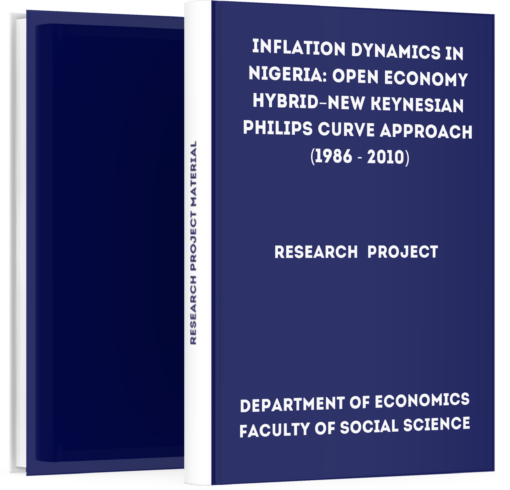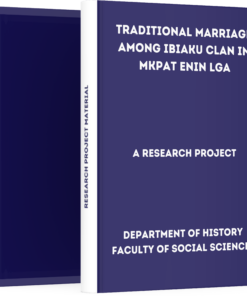Inflation Dynamics in Nigeria: Open Economy Hybrid–New Keynesian Philips Curve Approach (1986 – 2010)
₦3,000.00
If you are interested in getting this project material “Inflation Dynamics in Nigeria: Open Economy Hybrid–New Keynesian Philips Curve Approach (1986 – 2010)”, click on the DOWNLOAD BUTTON to make payment and the file will be delivered to your email immediately after confirmation.
Description
– Inflation Dynamics in Nigeria: Open Economy Hybrid–New Keynesian Philips Curve Approach (1986 – 2010) –
Download Inflation Dynamics in Nigeria: Open Economy Hybrid–New Keynesian Philips Curve Approach (1986 – 2010). Students who are writing their projects can get this material to aid their research work.
Abstract
The formal adoption of the inflation targeting policy framework by the CBN requires a good understanding of the inflationary process in Nigeria.
Central banks that adopt inflation targeting across the world use some variants of the New Keynesian Policy Model (NKPM) which in turn rely on the correct empirical specification of the New Keynesian Philips Curve (NKPC) because it is microfounded, hence immune to Lucas critique.
This study used the Generalized Method of Moments (GMM) statistical techniques to estimate the open-economy NKPC for Nigeria in order to determine if it fits the Nigeria’s data well and identify the empirical price-setting behaviour of the Nigerian firms.
It also seeks to assess the relative role of external factors on the inflation dynamics in Nigeria and determine the forecasting potential of the NKPC model for Nigeria’s inflationary process. The estimate shows that the open-economy hybrid NKPC model fit Nigeria’s data very well.
It also indicates that, although most firms are backward-looking, a significant proportion of firms in Nigeria are forward-looking, hence the CBN communication could be used to influence their price-setting behaviour and by implication inflation dynamics.
The estimate also reveals that exchange rate depreciation and relatively labour market dynamics have significant impact on inflation dynamics in Nigeria. Finally it is observed that the open-economy hybrid NKPC model could be used to set target inflation in Nigeria.
Introduction
1.1 Background of the Study
The short-run dynamics of inflation accompanied by cyclical interactions with real economic variables is a central issue of debate in macroeconomics and most especially in the analysis of monetary policy.
Initially these dynamics were explained by Philips (1958) who established a negative relationship between nominal wage and unemployment using United Kingdom (UK) as a case study.
The work of Philips gained support from Samuelson and Solow (1960s) who equally established an explicit link between unemployment and price inflation in the United States (US), hence the emergence of the term Philips curve.
According to Hornstein, (2008), the relevance of this curve stems from the fact that proponents of the Philips curve maintained that, the curve could better serve as a menu for monetary policy makers,
since it gives them the opportunity to either choose between high inflation and low unemployment or between low unemployment and high inflation.
The dilemma of choosing between inflation and unemployment broke in the 1970s leading to a situation known as “stagflation”, where both inflation and unemployment were found to rise simultaneously thus, casting doubts on the validity of the traditional Philips curve.
Korkmaz (2010) noted that the traditional Phillips curve is a standard model of expectations which is backward-looking, such that expected inflation is assumed to equal lagged inflation (or an average of several lags) hence explaining inflation from a macro perspective.
It therefore implies that the traditional Philips curve lacks a microeconomic foundation (Montoya and Björn, 2011).
How to Download this Project Material
First, note that we are one of the best and most reliable online platforms because we don’t retain any of your personal information or data as regards making payments online.
PRICE: ₦3,500 ₦3,000 (Three Thousand Naira Only)
Make a bank deposit or mobile transfer of ₦2,000 only to the account given below;
Bank Name: UBA Account Number: 1022564031 Account Name: TMLT PRO SERVICES
After making the payment, CLICK HERE to send the following on WhatsApp;
- Depositor’s Name or Screenshot of Payment
- Name of the Past Question
- Active Email Address
or Call Us On +2348082284439 Once your details have been received and your payment confirmed by us, you will receive the past question in your email or WhatsApp within 5 Minutes.
Guarantee of Getting the Material
We understand that due to the high rate of fraud, many people are afraid of making purchases online but be rest assured that PastExamQuestions will deliver your material after payment.
Once your details have been received and your payment confirmed by us, you will receive the past question in your email or WhatsApp.
Give us Feedback
Have we been able to satisfy you? How well do you think the material will be helpful after having gone through it? Does the price worth the material?
Let’s hear from you! We recommend that our customers give feedback at the end of every transaction to enable us to serve better. You can do this by clicking the review button on this page.
Where is the review button? >> Just scroll up to where you see reviews





Reviews
There are no reviews yet.